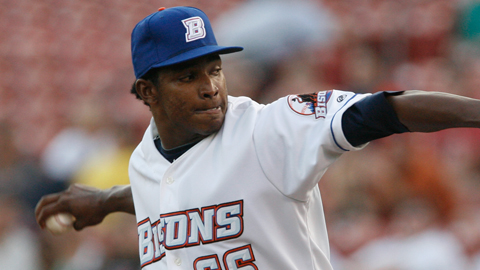 It wasn’t too long ago that when the subject of top Mets pitching prospects came up, the first two names that jumped to mind were righthanders Jenrry Mejia and Jeurys Familia. As a matter of fact, going into the 2011 season, both were still ranked as the two best pitching prospects in the Mets system.
It wasn’t too long ago that when the subject of top Mets pitching prospects came up, the first two names that jumped to mind were righthanders Jenrry Mejia and Jeurys Familia. As a matter of fact, going into the 2011 season, both were still ranked as the two best pitching prospects in the Mets system.
Anthony DiComo wrote a little about that this morning on Mets.com and it reminded me of how quickly and easily some top prospects can just fizzle and lose their shine. Some of them to be heard of no more until someone years later does a “Whatever Happened To __________”, just fill in the blank.
Not only were these particular two generating all this buzz in Mets camp, but MLB scouts everywhere were equally excited about 19-year old Mejia’s “dynamic cut fastball that made scouts dream about his future at the top of a rotation.”
And as DiComo states, it was also around this time a year ago, that all the hype in camp was surrounding Matt Harvey and Familia (Mejia was coming back from TJS) and many baseball people were profiling them as front-end starting pitchers with high impact.
Well certainly Harvey stepped up the most between the three and made a spectacular ten-game debut last season, but what about the other two?
Well more and more the discussion about Familia and Mejia seems to have them both ending up in the bullpen rather than the front end starters everyone thought they would be. Even Mets pitching coach Dan Warthen himself has said as much about each of them and has been for quite a while.
So what happened? Or maybe the better question is why does this keep happening to hundreds of top pitching prospects over the years?
The answer may not be as simple as it seems, but history does a pretty good job of explaining what goes wrong.
Most minor league pitchers can dazzle in Rookie or Developmental Leagues and suddenly out themselves on the map of many a top prospect list. Many of them continue to carry that through from Low-A tall the way to High-A. But then comes the steepest hurdle that all pitching prospects must eventually face – the jump to Double-A.
I spoke about that jump with Michael Fulmer and Steven Matz just last year, and I talked extensively about that hurdle only two weeks ago in an Interview I conducted with Jack Leathersich. It’s the jump all young pitchers look forward to because it puts them in the biggest spotlight that they’ve ever experienced in their pro careers – more visibility – and only two levels away from their dream of reaching the major leagues.
However, Double-A is also the level where many of baseball’s greatest pitching prospects have gone to pasture. Less than third of them will ever make it to the majors as the frontline starters they were projected to be, or the elite closers or setup men everyone expected.
More-so for the starters than the relievers, it comes down to the development of their secondary pitches, or adding an effective changeup. But in most of the cases it always comes down to their command and control.
In the lower levels hitters have a tendency to swing wildly and are less disciplined, but that changes as they develop and advance to the higher levels. All of a sudden these same hitters are not so easy to strike out even when you missed the strikezone wide by a foot.
I bring this up mostly because I thought about how many of our top arms have yet to get past High-A. We have a lot of great arms that will make any Met fans mouth drool including this one. We write about them on MMO every week and we follow their progress ever so closely. But this particular 2013 season is going to be a huge year with a lot riding on it for about a dozen or so of these exciting young arms – you know all the names – you know who I’m talking about.
Honestly, I would have bet the mother lode that a couple of those arms were going to be swapped for an outfielder this offseason.
The Mets have a dozen of them and I don’t believe there’s such a thing as a 14-man rotation yet, so why not deal from this strength especially coming off some great seasons in 2012? Especially because the outfield is our weakest organizational position with nothing close to major league ready or even Double-A ready. Matt den Dekker’s glove sure is, but so far his bat isn’t.
Getting back to my original point, the sad reality of what will happen with most of these pitchers and their “electric stuff”, to coin an often-used phrase from our friends at MetsBlog, is that this is what always happens with top level pitching prospects in baseball – fewer than a precious third of them will ever meet those lofty expectations.
And in the cases of Matt Harvey, Jeurys Familia and Jenrry Mejia – though sad in how it looks to be playing out – is not anything we’ve never seen before. This is the norm. This is baseball.














